The traditional season designations that would make September, October, and November “autumn” months don’t make a lot of sense in a climate like south Florida, where there are really only two seasons: wet and dry. The wet season lasts from May to October, and the dry season is November through April. When “fall” starts elsewhere in the country, with its glorious leaf falls of red and orange, and crisp, chilly weather, we’re still hunkered down indoors with the a/c on full blast. Later on, perhaps a day or two in late October or a week or so in November, we have a taste of chilly weather, punctuated by week-long spells of stiff breezes out of the east or northeast and, every now and then, a drop in humidity and temperature.
Most years by the end of November we’ll have had one or two cold fronts (daytime highs in the 60s or 70s, overnight lows in the 50s), out of the weeks and weeks of 80-degree highs and 70-degree nights. By Thanksgiving, though, most of the people who live down here are ready for some “real” autumn weather (as opposed to the snowbirds, who are here for the warmth).
Lacking the cold weather, though, we can at least go out and look at the snowbirds. And last week, as I’ve done for the past several years, I led a Saturday-after-Thanksgiving bird walk for my local Audubon chapter (Audubon Society of the Everglades) out at Green Cay Wetlands and Nature Center in Boynton Beach. And as has become the norm for these walks, the weather was somewhat uncooperative for “real” birding: a strong easterly wind made it hard to locate the smaller birds (your warblers, vireos, etc.) by one of my favorite methods: noticing the displacement of the foliage as they move about. Despite the mildly “bad” weather, though, it’s always fun to get out into something resembling nature (these wetlands were a pepper farm less than a decade ago) and see a few birds.
Here are some of the ones we found this year.
Pied-billed grebe
Although they are generally solitary, the abundance of “dabchicks” at our two created wetlands in PBCo (Wakodahatchee and Green Cay) make it seem like pied-billed grebes are almost gregarious. Another name for the PBGR is “hell-diver”; Arthur Cleveland Bent, writing in 1919, recalls
I can remember distinctly how much ammunition I wasted in my old muzzle-loading gun, when I was a boy, in vain attempts to bag the elusive “hell-diver,” as we used to call it. My attempts were seldom successful and I used to think that it dove at the flash of the gun; with a modern gun and nitro powder the results might have been different. Anything which even looked like a duck was considered legitimate game in those days and the silky grebes’ breasts were proudly presented to my girl friends.
Modern photographers can certainly identify with Bent’s frustration; this little bird is just as difficult to catch on film as it is with a gun. Part of this is because of its facility with swimming and diving. As Bent writes,
The pied-billed grebe is no less expert than others of its tribe in diving; ordinarily, in a hurried dive, it plunges forward and disappears like a flash, swimming away for a long distance under water, to appear suddenly at some unexpected spot or perhaps to vanish and keep out of sight; it also has the power so to contract its displacement that it can swim along with only its head and neck above water, or it can gradually sink down backward, like a disappearing frog, without making a ripple.
This swimming and diving ability is facilitated in part by its plumage (about which more in a minute) and in part by the peculiar, lobed feet it shares with the 20 other members of the family Podicipididae. Unlike the web-footed Anatidae (the duck tribe), grebes do not have webbing between their toes. Instead, they have lobed toes that function a little bit like oarb blades: the broad portion is perpendicular to the direction of motion on the power stroke, but parallel to it (hence presenting a very narrow profile) on the return stroke. Here’s an uncredited photo I found doing a Google image search that shows the feet in question (if this is your image, please let me know so I can give you credit!):
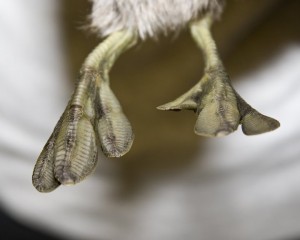
Although they are called pied-billed, the ring around the bill that gives them this name appears only during the breeding season. By an unusual stroke of luck, this one was just hanging out a few feet from the boardwalk; apparently it had forgotten that it was supposed to disappear before I could grab an image:
As you can see by its rather disheveled look, water doesn’t always flow off a waterbird’s plumage. The “wet look” is probably a result of how it controls its displacement so as to swim with only head and neck above water. Like the anhinga, and unlike ducks, whose plumage is nearly watertight, this grebe can control its buoyancy by squeezing water down in between the feathers to decrease its buoyancy. Unlike the anhinga, though, the grebe does have the “standard” waterproofing ability it gets from its uropygial gland.
But squeezing out the air to dive like a submarine isn’t the only interesting thing this bird does with its feathers. They also eat them! That is, the contents of their stomachs are often found to contain feather balls. There are two presumed reasons for this: to protect the stomach lining from being shredded by the bones of the fish they eat, and to slow digestion enough so that those bones are dissolved, rather than passing through the alimentary tract.
A bit farther down the boardwalk, we found the first of many “next” grebes swimming through the duckweed, and this one, too, failed to disappear before I could shoot it:
Because Green Cay is a relatively large area (about 100 acres), the county was able to engineer several different habitats in the wetlands, providing dry areas (tree hammocks, Cypress stands, and grassy berms) along with the wet. And because of this, a frequent winter visitor/resident is the Northern Harrier, a hawk of the wetlands that likes to perch and dine on nice dry ground. I don’t have the fastest or the most humongous lens on my camera, so this “artsy” shot is the best i could get:
As usual in a wetland setting, herons of many kind were in evidence; here are both green and tricolored:
Every wetland worth its salt—er, fresh water has dragonflies, and Green Cay is no exception. The dragonflies were thick throughout our walk; I’d have taken more pictures of them, but the wind made it quite difficult to get nonblurry shots of such delicate creatures. So I had to content myself with whatever images I could grab in the lee of one of the hammocks. This Eastern Pondhawk looks to have just emerged from its larval skin, but in fact it’s just coopted a spot above the exuvium of a much smaller species (presumably the Eastern Amberwing) that had emerged earlier.
References
Bent, A.C. (1919). Life Histories of North American Diving Birds. American National Museum Bulletin 107. Reprinted 1963, 1986, by Dover Publications, Mineola, NY.

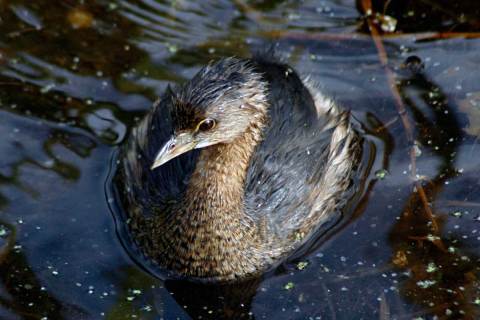
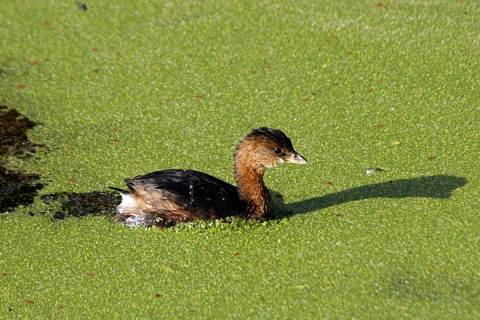
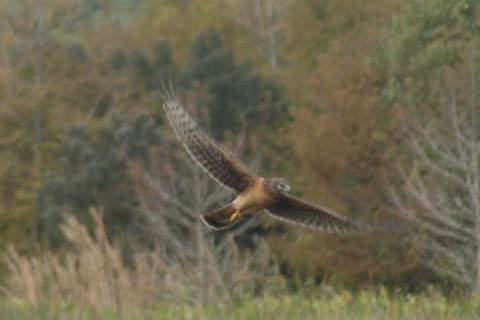
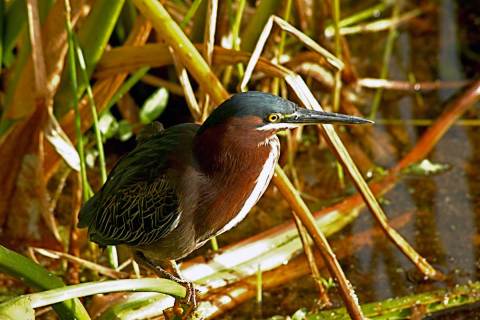
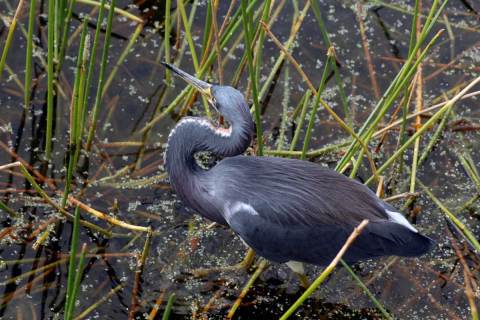
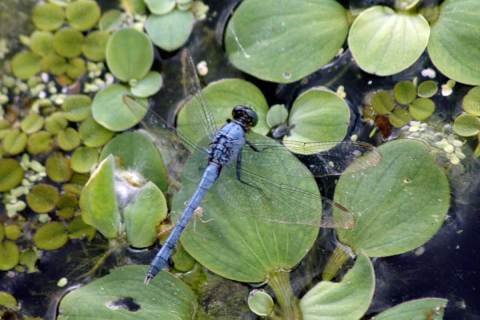
1 thought on “Thanksgiving birding at Green Cay”